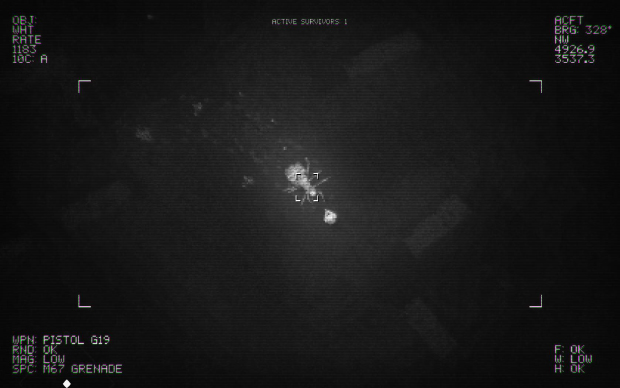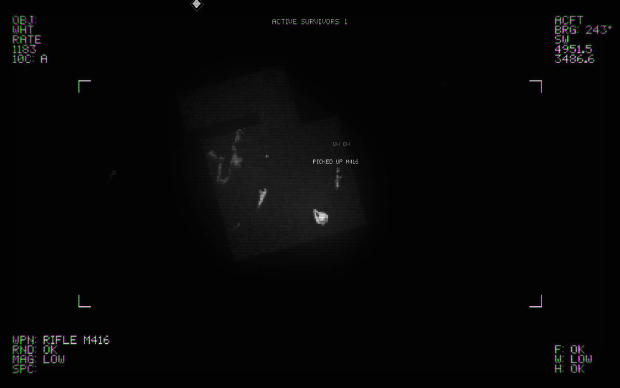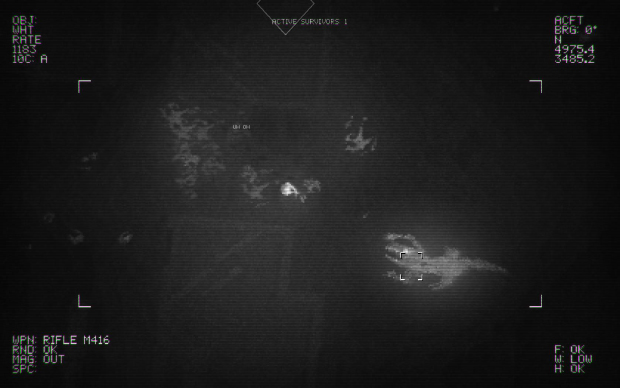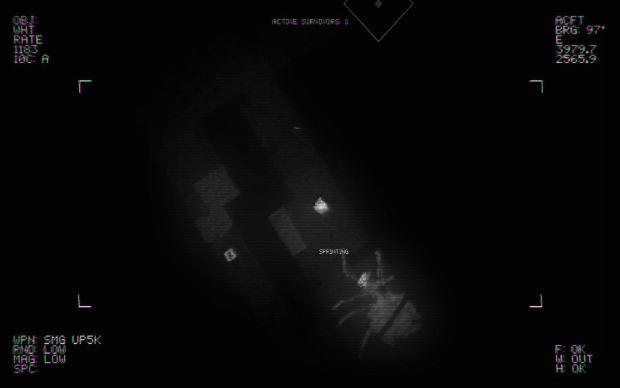Premature Evaluation: Noct
Nightstalker
Each week Marsh Davies reluctantly edges through the grey, dead land of Early Access and comes back with any stories he can find or otherwise gets ripped apart by centipedes. This week he’s been doing quite a lot of the latter in the post-apocalyptic Noct, a creepy top-down shooter, in which you play a succession of survivors attempting to follow a plan relayed to you by a distant radio operator.
If the key to good horror fiction is to encourage the audience's imagination to run away with them, then Noct must get that much right: judging by the Steam reviews, most people have imagined a much more interesting game than I’ve played. And while, yes, that is just a glib and petulant thing to say about a game that has annoyed me, it’s also to Noct’s credit that its aesthetic has convinced so many players to focus on how they feel, rather on the relative simplicity and repetition of what they are doing.
You view the world as if through the infra-red camera on a high-altitude plane or drone - a slowly listing monochromatic overview that tracks your hot white body trudging through the wilderness. As enemies approach, the screen vignettes, darkness choking in around the sides. Other than the eerie soundtrack and hiss of radio static, the world is largely rendered in silence - even the report of a gun is a distant, muffled percussion. It all creates a sense of immense, bleak isolation, compounded by your survivor’s fragility: mere contact with any monster and the screen will wink out like a dying CRT telly. And this will happen again and again and again, until you learn to approach every outbuilding and warehouse with the appropriate caution.
The problem is, it happens again and again even if you do use the appropriate caution. In fact, there is no possible level of caution which is appropriate, so quick, so impervious to bullets and so instantly lethal are nearly all your foes. And this repetition successfully stripped the game of its menace for me, revealing it in bald terms to be a stodgy shmup with sparse tactical options and an awful lot of fetch-quest trudging. The core loop of action here doesn’t yet permit the rest of the game, with its cautious worldbuilding and sinister atmosphere, to reach its potential - and perhaps it is for this reason that the game has opted to stay in Early Access until January, rather than go for a full launch last week as previously planned.
On starting a new game, your survivor (a term which will soon be very inaccurate) is contacted by a radio operator, presumably also in charge of the Eye in the Sky through which we view the game world. You are told of a nearby cache of ammunition and, through subsequent radio blurbs, inveigled into a quest to save the land - or so you are told. It’s an effective and concise way of relaying the backstory of the world, and I am intrigued by it, but the questing itself involves no more than moving to a succession of waypoints that criss-cross the map, which, being rendered in a narrow band of fuzzy greys, does little to encourage sightseeing.
Shortly after my first instruction from the operator, I find the darkness crowding in. Just above my character, the words “Uh oh” appear - a sign that danger is close by. Duly, a monster emerges from the dark - a mutated crocodile, perhaps - twice the size of a car with gigantic forelimbs and a snaking tail. I fire at it rapidly, and though all my shots hit, it chomps me before I can kill it. But that’s okay, as I am instantly restarted as another survivor, and after a brief discussion with the Eye in the Sky, I am sent off to loot my own corpse. Assuming the crocodile is still about, I decide I should figure out how to sprint, but instead accidentally throw a grenade I didn’t know I had (thanks to the randomisation of starting load-outs) and blow myself up. I imagine the radio operator mouthing, “Oh for fuck’s sake,” before slowly lowering his head into his hands.
On my third life, I make it back to my body. Once I’ve pocketed all my previous inventory (minus one grenade, of course), I pick up the quest where the previous not-survivor left it. This is a smart way of preserving progress given that, even when I’m not doing something fatally idiotic, death is frequently arbitrary and unavoidable. So much so that, in spite of this clever compromise, I nonetheless quickly resent the journey back to my body too.
Now I’m here, however, the waypoint flits across the map to a derelict ship, upon which I am meant to find a valve. Not that you’d be able to tell it was a ship, given how uniformly indistinct everything is - it’s hard to determine what’s an obstacle and what’s a floor tile, what’s a building or a block of impassable matter, what’s a door or a wall. If you enter a structure, the interior is revealed but the world outside recedes into total darkness. Enemies are also only visible in line of sight - which is a peculiar disempowerment given the overhead infrared view. The camera otherwise insists it is a true thing in the game world and not merely a convenient perspective: it slowly rotates, as though the aeroplane it’s attached to is circling, completely reorienting the screen.
Luckily, the waypointing system is clear enough, and the landscape is so grimly featureless that the rotation of it doesn’t really impact your navigation. After some back and forth, fetching a key from a corpse and the valve from a lockbox, I leave the ship for a nearby town. Three components are scattered inside - though I seem to have missed what I’m meant to be assembling them into, perhaps because dialogue is displayed across the centre screen while I am in panicky retreat from a monster, forcing me to rapidly skip it to see the action occurring beneath. A trio of well-aimed shots from a rifle I have scavenged seem to deter the beast, but another croc weaves around a crate behind me. I attempt to throw a grenade, but I don’t have one, and nor does the sprint button work - perhaps because I have entered the “thirsty” state due to depleted water supplies. I am dead.
I spawn the other side of some woodland, and make a beeline for my corpse. I die pretty much instantly to a giant centipede which pops out of a building, and spawn again, even further away away. Trudge, trudge, trudge. Dead again - this time to a spider, and then again to a croc. The enemy animation has a creepy marionette quality to it I very much like, but I don’t really find their behaviour all that readable. Crocs will weave about, curling in on themselves, before abruptly pelting straight at you, then sometimes wandering away. It’s not clear that bullets do much to incentivise them one way or the other, and if they do decide to go for you they move faster than you can run and, unless you’ve been pumping shots into them continuously ever since they emerged from the edge of the screen, you can’t easily kill them before they get their jaws on you.
I manage to improve my odds by engineering circumstances in which enemies can only approach across open ground - and I kill a fair few centipedes and crocs, successfully looting the town of its precious components. But then I make the mistake of entering a house. A croc emerges through the wall - or was it a door that looked like a wall? - and kills me immediately. Whatever horror the game’s world held has entirely drained from it - I am bored now, and I continue to be bored during my many subsequent unavoidable deaths as I journey on, to the hydroelectric dam where my next waypoint lies. There I activate some switches and get killed by monsters that erupt from the darkness to chase me down a corridor, somehow surviving my grenades. The drama of this scripted shock is lessened by all the previous, unavoidable and identically sudden deaths. I head to the crash-site of a chopper and get killed by a centipede. I spawn a distance away and traipse back and back again, and though I kill many enemies along the way, all I am rewarded with in the end is another waypoint to go to in this grey land.
The little snippets of dialogue your character has with the Eye in the Sky, the soft dissonant music and heavy sense of dread - the great appeal of these things just doesn’t survive the repetition of the game’s limited action, for me at least. The difficulty isn’t a problem as, blessedly, progress occurs regardless of your deaths, but the transition between life and death is too abrupt for you to exert much intelligent mastery over its avoidance. Compared with Teleglitch, a top-down horror-shooter with a reputation for considerable difficulty, the encounters with monsters in Noct are not more interesting for being so quickly fatal, and its options for the player far, far fewer. Noct can be played online too, and, in my brief experience, the addition of other players only makes the game more instantly deadly - but it’s hard to say if greater cooperation is possible because the servers I’ve found aren’t sufficiently populated to make these friendly encounters likely. By the time the full release rolls round in January, it may well be that enhanced survivability and a broader range of abilities in combat set players free of the narrow-focus drudgery of the game’s core loop - but only then, I suspect, will Noct meet the potential of its own frightful imagination.
Noct is available from Steam for £7. I played version 0.17.9B on 31/10/2015.





